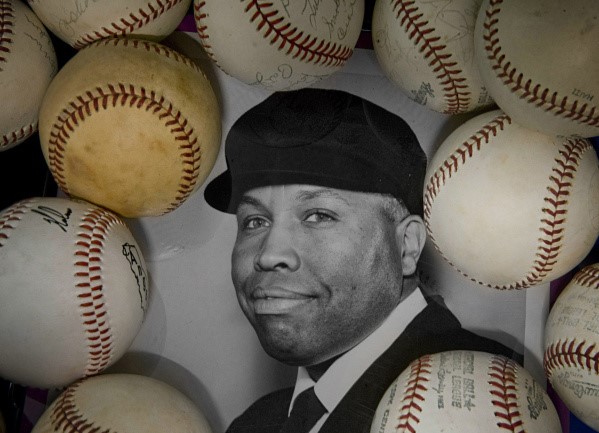Scroll Down to Read Today’s Essay
Subscribe to Baseball History Comes Alive for automatic updates. As a Free Bonus, you’ll get instant access to my Special Report: Gary’s Handy Dandy World Series Reference Guide!
As part of our continuing coverage of Black History Month, we welcome Andrew Sharp with an interesting essay about the career of the major league’s first African-American umpire, Emmett Ashford. Many of us remember Emmett fondly and his animated calls on the field. I think you’ll enjoy Andrew’s essay. -GL
Emmett Ashford’s Debut comes at D.C. Stadium,
April 11, 1966
Emmett Ashford had trouble getting into D.C. Stadium on April 11, 1966, to become the first Black umpire in the Major Leagues.
A Secret Service detail protecting Vice President Hubert Humphrey, there to throw out opening day’s ceremonial first pitch, stopped Ashford under the grandstands as he entered the stadium.
“Listen, there are no Negro umpires in the Major Leagues,” one doubting agent told the would-be rookie arbiter. “Well, there will be a Negro umpire in the American League, if you will let me into the park,” Ashford replied. After 10 minutes of checking his identification, the agents let Ashford go on his way.
Ashford, a veteran AAA umpire, knew he would be brought up to the A.L. when his contract was purchased from the Pacific Coast League on September 10, 1965. He had begun umpiring in 1951 in the Southwestern International League and then the Arizona-Texas League. He spent 12 years in the PCL, the last three as the umpire-in-chief. He had become a fan favorite, which to some was a reason – in addition to his race — he had not been moved up to the majors.
Noted for his demonstrative calls and animated style, Ashford told the Sporting News during 1966 spring training: “I guess you can say I’m colorful. I’m colorful in two ways…. Everybody says that baseball needs more color, and nobody can fill the bill like I can.”
Mark Armour, the founder of SABR’s BioProject, wrote the biographical essay on Ashford’s life, which I would highly recommend, at sabr.org
The 51-year-old Ashford worked third base in Cleveland’s 5-2 victory at D.C. Stadium. ““I’ve got butterflies,” he told Bob Addie of the Washington Post before the game. After the game, the vice president was among those who congratulated Ashford.
“Emmett, you didn’t have a chance to miss one today,” Humphrey said. “No plays, no boots … but it was the greatest day of my life,” Ashford responded. Later, he told sportswriters that finally making the majors “was just wonderful. The players came up and shook my hand.” Senators’ manager Gil Hodges, a longtime teammate of Jackie Robinson, wished him luck.
The opening day crowd was 44,468, a record at the time for a Senators’ opener. The only safe-or-out call Ashford had to make was when Vic Davalillo slid into third base far ahead of a throw.
Frank Howard, who throughout his career had great success against Cleveland starter Sam McDowell, blasted a line-drive homer in the sixth inning that hit the foul pole. The hit left an impression on Ashford.
“I learned (that) when Mr. Howard comes to bat, third base is not the healthiest spot.” Ashford said. “The way he swings, if the breeze doesn’t get you, his ball might put a hole right through you.”
The Post ran a photo the next day of Ashford and fellow ump Bob Stewart, taken before the game. Stewart handled first base. John Stevens was the home-plate umpire and Bill Haller was at second. After the game, “Bill gave me an opening-game ball with their signatures,” Ashford told the Sporting News. “I’ll keep it always.”
“Emmett, today you made history,” Joe Cronin, the A.L. president who attended the game, told the rookie umpire. Cronin, Ashford conceded, “had bucked certain odds to give me the chance…. Somebody had to break in, and I’m proud it was me.
“Mr. Cronin said when he hired me, ‘Emmett, be yourself. Don’t change,'” Ashford told reporters in response to critics who called him a showboat. “I just want to be thought of and judged as another rookie umpire…. And I’ll say that a sense of humor has made life easier for me.”
Ashford eventually worked the 1967 All-Star game and the 1970 World Series. He was scheduled to be behind the plate for Game 6, but the Orioles won the series in Game 5. Ashford was allowed to work a season beyond the league’s mandatory retirement age of 55, but he called it quits after the 1970 season.
After retiring from umpiring, he worked for the commissioner’s office and was frequently seen on screen, with a part in the film The Bingo Long Traveling Al-Stars & Motor Kings and appearances on TV in Ironside and The Jacksons. In 1966, he had been a guest on What’s My Line?
Emmett Ashford died of a heart attack at 65 in Marina del Ray, California, on March 1, 1980. Although his body was cremated, his wife sent his ashes to Cooperstown, N.Y., where he is the only significant figure in baseball history buried near the National Baseball Hall of Fame and Museum.
In 2009, Rachel Robinson, Jackie’s widow, wrote to the Hall of Fame’s board of directors advocating for Ashford’s inclusion on a future veterans committee ballot. However, that has yet to happen.
This article also appeared in March 2022 in the daily Internet Baseball Writers Association newsletter, Here’s the Pitch
Andrew Sharp
Andrew Sharp is SABR member and a longtime Washington baseball fan.
Subscribe to our website, Baseball History Comes Alive with over 1400 fully categorized baseball essays and photo galleries, now surpassing the one million hits mark with 1,153,000 hits and over 950 subscribers: https://wp.me/P7a04E-2he

